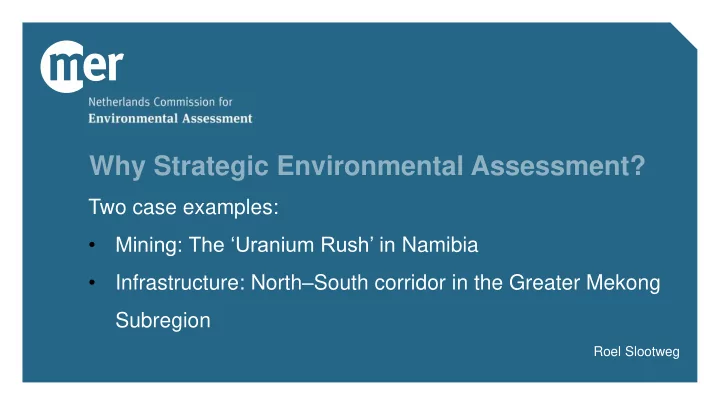

Why Strategic Environmental Assessment? Two case examples: • Mining: The ‘Uranium Rush’ in Namibia • Infrastructure: North – South corridor in the Greater Mekong Subregion Roel Slootweg
2 SEA for Uranium mining in Namibia • World market for uranium favourable • ‘Scramble’ for exploration licenses: 36 in Erongo region (all subject to separate EIAs) • No coherent development vision for this region • Result: Ministry of Mines and Energy put a moratorium on mining licenses and called for an SEA • Question: • How can authorities and other stakeholders best manage the “Uranium Rush” • How to ensure that uranium mining contributes to sustainable development of the region
Erongo region: coastal desert area with temporary rivers, important for: • Biodiversity conservation; tourism; livestock; mining; archeology; train and road transport; harbour facilities.
SEA: Potential benefits of mining • Increased government revenues / foreign reserves • Economic stimulus to Namibian economy • Employment & skills development • Infrastructure development / upgrading • Social, environmental and economic development • Upgrade of health facilities • Namibia’s international reputation on sustainable development
SEA: Potential (cumulative) constraints • Impacts on water (availability) • Impacts on biodiversity and heritage (archeology) • Impacts on health (e.g. radiation) • Impacts on tourism and recreation • Stress on physical infrastructure • Impacts on towns and social structures • Stress on government ministries
ToR for SEA • Develop / assess scenarios of mining and associated developments as a basis for decision-making and planning. • Recommendations on sustainable mining in Erongo Region. • Provide solutions on (cumulative) impacts and challenges stemming from the mining operations. • Outline a Strategic Environmental Management Plan (SEMP)
Effects of SEA • Better prepared government agencies • Insight into interests of different sectors and their stakeholders (also spatially) • Biodiversity, tourism and heritage ‘hot spots’: no -go areas • SEMP provides framework for individual mine EIA and license • Government ‘ panic ’ turned into responsible mine development
8 Sensitive biodiversity areas
In general: what project EIA can NOT do • Solve institutional weakness of a country (regulations, policies, expertise) • Balance the interests of mining sector against other interests • Cummulative effects of numerous mining activities • Assess the contribution of mining to national or regional inclusive and sustainable growth
Advantages of SEA For companies: • Government is well-prepared • Regulations are in place • Roles and responsibilties for private and public actors are clear (level playing field) For government: • Better prepared for new developments (institutions / capacity) • Division of tasks between government agencies defined • Anxieties and aspirations of stakeholders known For society • Mining contributes to regional development • Negative consequences minimised and under control • Weakest groups in society known and protected
Levels in decision-making for mining activities • T i e r i n g SEA for national mining sector planning • SEA for regional development planning (the Namibia example) • EIA for individual mining projects
Infrastructure and economic corridors in GMS • Corridor as ‘backbone’ for economic integration and poverty erradication • Transport needs (people, goods, power, water, communication) • Starting with broadly defined corridors, further specified at lower planning level
Transboundary Biodiversity Landscapes in GMS Region Mapping of: • Existing protected areas • Additional protected corridors (connectivity) • Sustainable use areas for local population SEA: overlay with routing alternatives of economic corridors Source: Core Environment Program (www.gms-eoc.org)
North-South Economic Corridor (NSEC) SEA with spatial multi-criteria analysis: • Mapping ecological and social high risk areas to be avoided (biodiversity corridor; territory of vulnerable groups). • Giving different weights to economic, ecological, and social criteria provides alternative routings • Leading to a better informed decision on the selected routing alternative.
Ex ante Ex post
SEA for Infrastructure & Economic Corridors Levels of decision making: T i e r i n g • SEA for (international) corridors plans (biodiversity corridor example). • Programme SEA: alternative transport modes and routings within corridor (NSEC example) • Project EIA: implementation of projects
NCEA cases available Mainstreaming of biodiversity in: • Mining • Infrastructure and economic corridors • Hydropower • Regional / spatial planning More info: www.eia.nl
Recommend
More recommend